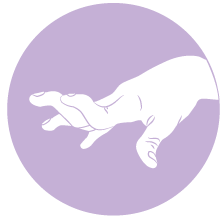Specific problems
Spasticity in children is mostly due to cerebral palsy. It occurs at birth or during the first two years of life. Once established, it is non progressive. It may impair one limb (arm or leg: monoplegia), two limbs (one side of the body: hemiplegia), or all four limbs (quadriplegia).
Children learn very early on to live with it and to adapt naturally to the deficit. Hemiplegic children develop amazing performances with the contra-lateral normal arm. They also naturally tend to ignore the impaired arm, despite functional possibilities. and may end up “forgetting “ it unless they are encouraged to use it. Occupational therapy plays an outstanding role in this education.This is not true of the spastic lower limb (leg) which is essential for walking.
 Therefore the upper limb must be managed early with physical and occupational therapy, in order to develop its potential and fully use its capacity, even though limited. Some of the specific problems in children affecting the upper limb include hyperlaxity of the finger joints (“swan neck” ) and the thumb, Abnormal movements
Therefore the upper limb must be managed early with physical and occupational therapy, in order to develop its potential and fully use its capacity, even though limited. Some of the specific problems in children affecting the upper limb include hyperlaxity of the finger joints (“swan neck” ) and the thumb, Abnormal movements
Abnormal movements, also referred to as “movement disorders”, occur involontarily and out of the patient’s control. They can occur at rest or during activity. In spastic patients, the most frequent abnormal movements are:
-dystonia, characterized by sustained muscle contractions cause twisting and repetitive movements or abnormal postures. Dystonia is often initiated or worsened by voluntary movements, and seems due to a lack of motor coordination (lack of reciprocal inhibition of agonist / antagonist muscles). In the upper limb it often produces abnormal postures in ulnar deviation of the wrist, and in finger extension when the wrist is flexed. Severe dystonia is a contra-indication to surgery.
- chorea is made of brief, semi-directed, irregular movements that are not repetitive or rhythmic, but appear to flow from one muscle to the next ('dance-like' movements).
- athetosis is characterized by slow, involuntary, convoluted, writhing movements of the fingers, hands, toes, and feet and in some cases, arms, legs, neck and tongue. It can be quite permanent, ceasing only during sleep. such as dystoniadystonia, characterized by sustained muscle contractions cause twisting and repetitive movements or abnormal postures. Dystonia is often initiated or worsened by voluntary movements, and seems due to a lack of motor coordination (lack of reciprocal inhibition of agonist / antagonist muscles). In the upper limb it often produces abnormal postures in ulnar deviation of the wrist, and in finger extension when the wrist is flexed. Severe dystonia is a contra-indication to surgery.. In selected cases, surgery can be very effective in restoring a good function, provided it is performed early, and followed by careful rehabilitation therapy
Timing of surgery
Spastic children usually require long term specific medical and paramedical care. Surgery may be necessary very early on if a deformity (i.e. severe elbow or wrist contracture) increases despite adequate rehabilitative treatment (physiotherapy and splinting).
In cases where the goal of surgery is to improve function, it can be performed as early as 6 years of age. If functional surgery is delayed until adolescence, by then the child has learnt other ways of prehension depending on the contralateral healthy limb, and when more normal patterns are restored through surgery, the older child may experience important difficulties in reprogramming his/her brain in order to achieve these “new“ functions.






